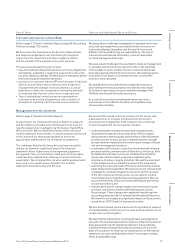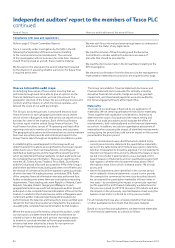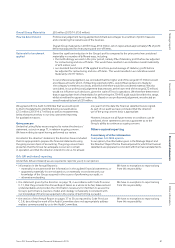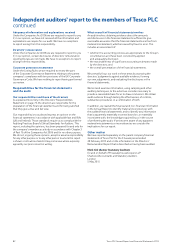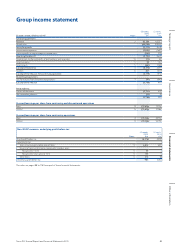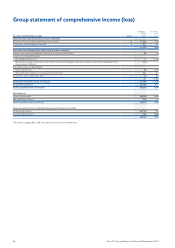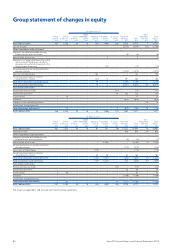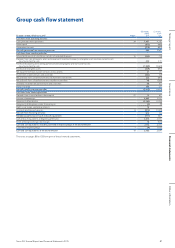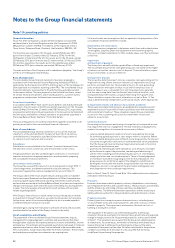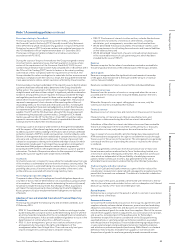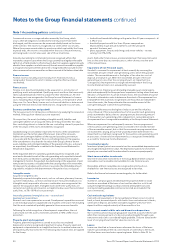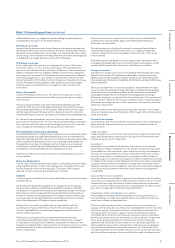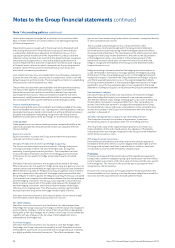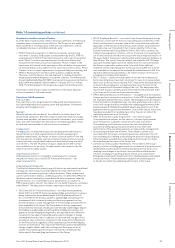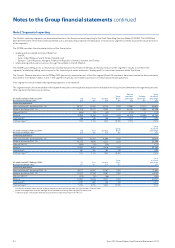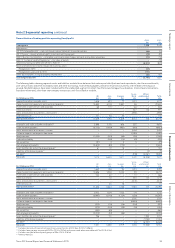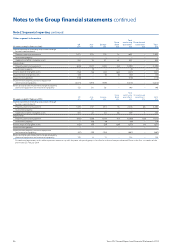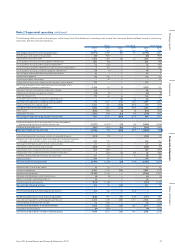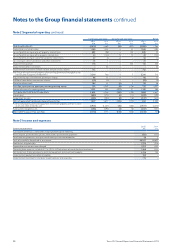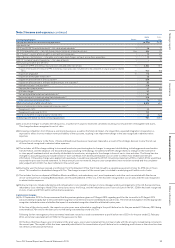Tesco 2015 Annual Report Download - page 91
Download and view the complete annual report
Please find page 91 of the 2015 Tesco annual report below. You can navigate through the pages in the report by either clicking on the pages listed below, or by using the keyword search tool below to find specific information within the annual report.
Note 1 Accounting policies continued
Provisions relating to Tesco Bank
The Group has provisions for potential customer redress. In 2010/11,
the Financial Conduct Authority (‘FCA’) formally issued Policy Statement
10/12 (‘PS 10/12’), which introduced new guidance in respect of Payment
Protection Insurance (‘PPI’) customer redress and evidential provisions to
the FCA Handbook with an implementation date of 1 December 2010.
TheGroup continues to handle complaints and redress customers in
accordance with PS 10/12.
During the course of the prior financial year the Group instigated a review
of certain historic operational issues that had resulted in instances where
certain of the requirements of the Consumer Credit Act (‘CCA’) for post
contract documentation had not been fully complied with. In November 2013
the Office of Fair Trading (‘OFT’) wrote to lenders in the industry seeking
confirmation of their compliance with the requirements of the CCA. The
Group extended its earlier investigation to undertake further assurance work
relating to compliance with the CCA. As a result, the Group determined that
it was appropriate to redress certain customers affected by these breaches.
Extensive analysis has been undertaken of the relevant issues to identify where
customers have been affected and to determine if the Group should take
further action. The requirements of the CCA in respect to these issues are not
straightforward and have not been subject to significant judicial consideration
to date. In arriving at the provision required, the Group considered the legal
and regulatory position with respect to these matters and has sought legal
advice which it took into account when it made its judgement. The provision
represents management’s best estimate at the reporting date of the cost
of providing redress to those loan and credit card customers. In making the
estimate, management have exercised judgement as to both the timescale
for implementing the redress campaign and the final scope of any amounts
payable. The OFT and the FCA have been advised of the Group’s approach
to determining the proposed customer redress. Oversight of CCA-related
matters passed from the OFT to the FCA on 1 April 2014. Customer redress
payments commenced in October 2014 and it is expected that these will
continue into the first half of the next financial year.
The Group is part of an industry-wide Scheme of Arrangement established
with the support of the relevant regulatory and customer protection bodies
to address customer redress relating to the historic sale of certain cardholder
protection products (‘CPP’) to credit card customers. Another industry-wide
Scheme of Arrangement has been established to compensate those customers
who were sold a similar product in earlier years. The level of provision held
is based on assumptions relating to the number and value of cases for which
compensation may be paid. In arriving at these assumptions management
have exercised their judgement based on earlier redress programmes
(including the CPP Scheme of Arrangement) and historic customer payment
information. The level of the provision allows for the repayment of charges
paid by the customer together with simple interest of 8.0%.
Inventories
An inventory provision is booked for cases where the realisable value from sale
of the inventory is estimated to be lower than the inventory carrying value. The
inventory provision is estimated taking into account various factors, including
prevailing sales prices of inventory item, the seasonality of the item’s sales
profile and losses associated with slow moving inventory items.
Post-employment benefit obligations
The present value of the post-employment benefit obligations depends on
a number of factors that are determined on an actuarial basis using anumber
of assumptions. The assumptions used in determining the netcost (income)
for pensions include the discount rate. Any changes in these assumptions
will impact the carrying amount of post-employment benefit obligations.
Key assumptions for post-employment benefit obligations are disclosed
in Note 26.
Adoption of new and amended International Financial Reporting
Standards
The Group has adopted the following new and amended standards as of
23 February 2014:
• IFRS 10 ‘Consolidated financial statements’ builds on existing principles
by identifying the concept of control as the determining factor in whether
an entity should be included within the consolidated financial statements
of the parent company. It also provides additional guidance to assist in the
determination of control where this is difficult to assess;
• IFRS 11 ‘Joint arrangements’ gives a more realistic reflection of joint
arrangements by focusing on the rights and obligations of the
arrangement rather than its legal form. There are now only two types
of joint arrangements: joint operations and joint ventures;
• IFRS 12 ‘Disclosures of interests in other entities, includes the disclosure
requirements for all forms of interests in other entities, including
subsidiaries, joint arrangements, associates and structured entities;
• IAS 32 (Amended) ‘Financial instruments: Presentation’ clarifies some
of the requirements for offsetting financial assets and financial liabilities
on the balance sheet; and
• IAS 36 (Amended) ‘Impairment of assets’ removed certain disclosures
of the recoverable amount of cash generating units which had been
included by the issue of IFRS 13.
Revenue
Revenue comprises the fair value of consideration received or receivable for
the sale of goods and services in the ordinary course of the Group’s activities.
Sale of goods
Revenue is recognised when the significant risks and rewards of ownership
of the goods have transferred to the buyer and the amount of revenue
can be measured reliably.
Revenue is recorded net of returns, discounts/offers and value added taxes.
Provision of services
Revenue from the provision of services is recognised when the service is
provided and the revenue can be measured reliably, based on the terms
of the contract.
Where the Group acts as an agent selling goods or services, only the
commission income is included within revenue.
Financial services
Revenue consists of interest, fees and income from the provision of insurance.
Interest income on financial assets that are classified as loans and
receivables is determined using the effective interest rate method.
Calculation of the effective interest rate takes into account fees receivable
that are an integral part of the instrument’s yield, premiums or discounts
on acquisition or issue, early redemption fees and transaction costs.
Fees in respect of services (credit card interchange fees, late payment and
ATM revenue) are recognised as the right to consideration accrues through
the provision of the service to the customer. The arrangements are generally
contractual and the cost of providing the service is incurred as the service
is rendered.
The Group generates commission from the sale and service of motor and
home insurance policies underwritten by Tesco Underwriting Limited, or in
a minority of cases by a third party underwriter. This is based on commission
rates which are independent of the profitability of underlying insurance
policies. Similar commission income is also generated from the sale of
white label insurance products underwritten by other third party providers.
Clubcard, loyalty and other initiatives
The cost of Clubcard and loyalty initiatives is part of the fair value of the
consideration received and is deferred and subsequently recognised over the
period that the awards are redeemed. The deferral is treated as a deduction
from revenue.
The fair value of the points awarded is determined with reference to the fair
value to the customer and considers factors such as redemption via Clubcard
deals versus money-off-in-store and redemption rate.
Rental income
Rental income is recognised in the period in which it is earned, in accordance
with the terms of the lease.
Commercial income
Consistent with standard industry practice, the Group has agreements with
suppliers whereby volume-related allowances, promotional and marketing
allowances and various other fees and discounts are received in connection
with the purchase of goods for resale from those suppliers. Most of the income
received from suppliers relates to adjustments to a core cost price of a product,
and as such is considered part of the purchase price for that product.
Sometimes receipt of the income is conditional on the Group performing
specified actions or satisfying certain performance conditions associated
with the purchase of the product. These include achieving agreed purchases
or sales volume targets and providing promotional or marketing materials
and activities or promotional product positioning. Whilst there is no standard
definition, these amounts receivable from suppliers in connection with
the purchase of goods for resale are generally termed commercial income.
89Tesco PLC Annual Report and Financial Statements 2015
Other informationGovernance Financial statementsStrategic report


